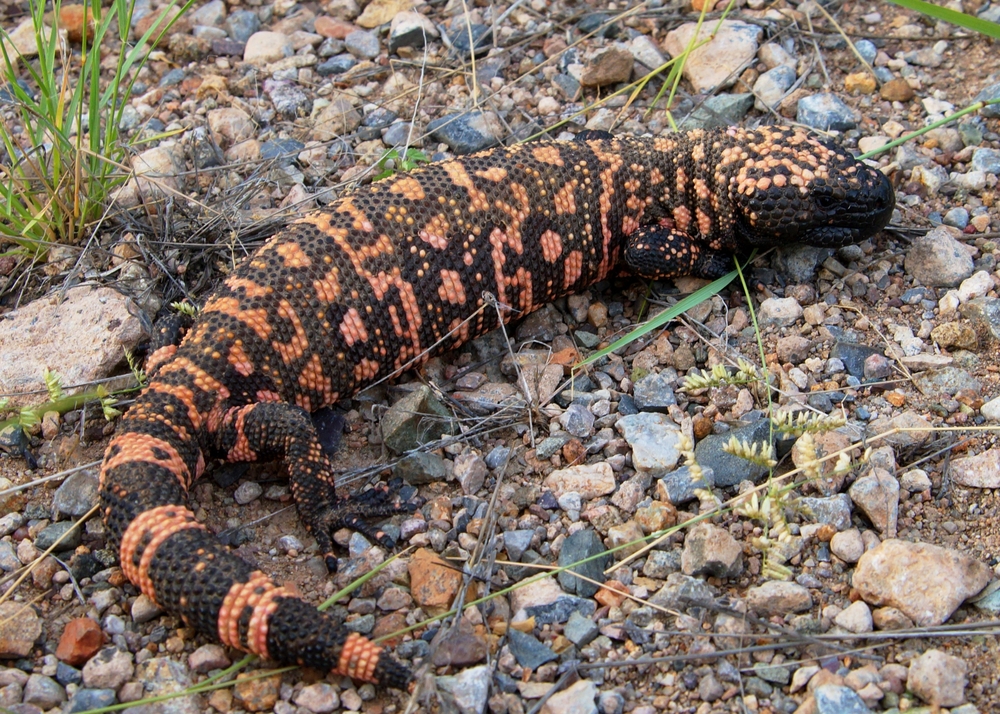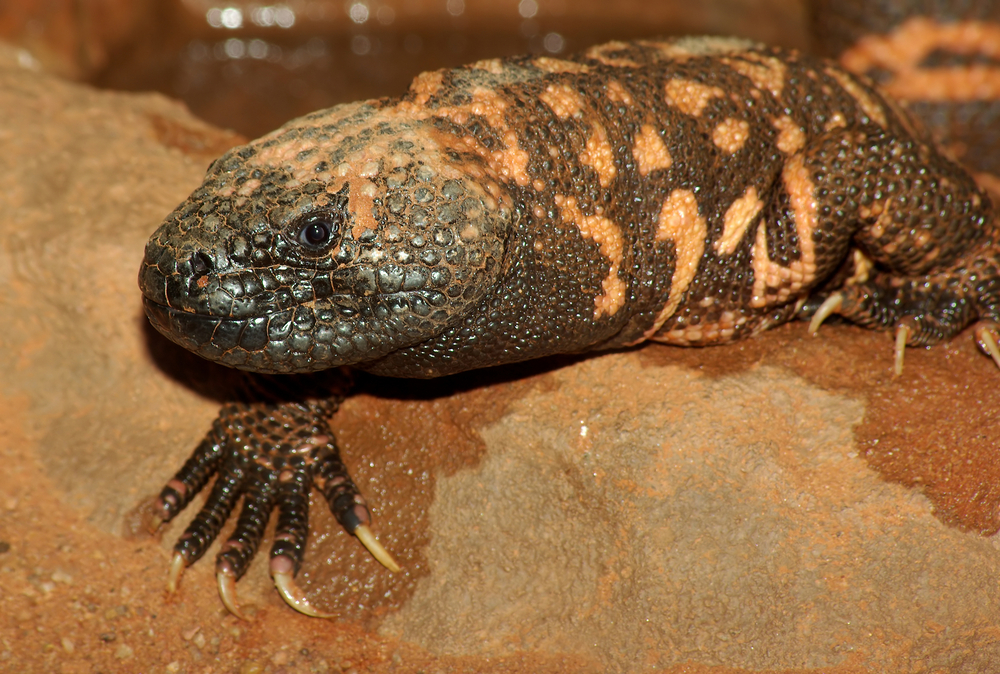Facts About Gila Monsters

Gila monsters are the largest lizards native to the United States. They get their name from Arizona's Gila River basin, where they were first discovered. Gila (pronounced hee-la) monsters are also one of only two venomous lizards in the world.
Size and description
Gila monsters have large and stout bodies with short, fat tails. They typically grow to around 20 inches (50 centimeters) and weigh around 4 lbs. (1.8 kilograms), according to National Geographic.
Their heads and necks are broad and their eyes are black with round pupils. Their bodies are covered with beaded scales and bright black, pink, yellow and orange patterns. Their wide feet end with long, sharp claws.
Habitat
Gila monsters are only found in the Sonoran, Mojave and Chihuahuan deserts in the southwestern United States and northwestern Mexico.
Gilas spend around 95 percent of their lives in their homes, which are underground burrows located in rocky foothills, according to National Geographic.
Habits
A group of these lizards is called a lounge, which is appropriate since they love to lie around and soak up the sun's rays. In fact, other than eating, sunbathing is the only reason a Gila monster will leave its home underground.
When a Gila monster is active depends on the weather. If it's a really hot day, the lizard may choose to only come out at night. If it's a cooler day, the other hand, the lizard may make an appearance while the sun is up.
Get the world’s most fascinating discoveries delivered straight to your inbox.
Offspring
Like other lizards, Gilas lay eggs. A female can lay three to 13 eggs at a time, and she incubates them for around four months. The eggs are usually about 2.5 inches (6.3 cm) long and weigh about 1.4 ounces (40 grams). At birth, a baby Gila is around 6.3 inches (16 cm) long.
Gila monsters take three to five years to mature and live 20 to 30 years.
Diet
Gila monsters are carnivores, which means they eat meat. Since they are on the lazy side, they tend to prefer easy prey, such as eggs and newborn mammals. These animals don't even chew their food and can even swallow small eggs whole. Gilas may also eat frogs, rodents, insects, lizards, worms and carrion.
If they can't get out of their burrow to forage, no problem. Gilas store fat in their tails and can go for months without food. They especially use this trait during the winter and will stay inside all season long.
When it does eat, it goes big. A Gila monster can gulp down a third of its body weight in one meal, according to the San Diego Zoo.
Chewy bite
Gila monsters apparently use their venomous saliva for defense rather than hunting, according to the Animal Diversity Web. When attacked, the Gila monster clamps down and doesn't let go, according to the Arizona Poison and Drug Information Center. The toxin comes from the glands in their jaws, though grooves in the animal's teeth into the broken skin of its victim. Gilas chew into the flesh to make sure the venom is deposited.
The bite is described as extremely painful, but the poison isn't deadly to humans in most cases. The pain is generally confined to the bite area, according to Arizona's Poison Center. It also may cause localized swelling, nausea, vomiting, high blood pressure, weakness, faintness, excessive sweating, chills and fever.
Currently, there is no antivenom for Gila monster bites. The first step to treatment is making the lizard let go. A strong stick to pry apart the jaws is recommended. First aid may include irrigating the wound with water and immobilizing the affected limb at heart level. The wound should be checked for broken teeth. Anyone bitten by a Gila monster should seek immediate medical treatment.
Classification/taxonomy
Here is the taxonomy information for Gila monsters, according to the Integrated Taxonomic Information System (ITIS):
Kingdom: Animalia Subkingdom: Bilateria Infrakingdom: Deuterostomia Phylum: Chordata Subphylum: Vertebrata Infraphylum: Gnathostomata Superclass: Tetrapoda Class: Reptilia Order: Squamata Suborder: Autarchoglossa Family: Helodermatidae Genus: Heloderma Species: Heloderma suspectum Subspecies: Heloderma suspectum cinctum (banded Gila monster), Heloderma suspectum suspectum (reticulate Gila monster)
Conservation status
Gila monsters are listed as near threatened on the International Union for Conservation of Nature's Red List of Threatened Species. It is estimated that the population is declining, though there are no exact numbers.
The United States and Mexico prohibit the collection of Gila monsters throughout their range, according to the IUCN. Sizable areas of habitat are protected from development in national parks and monuments and in federal wilderness areas.
Other facts
The other venomous lizard is the Mexican beaded lizard (Heloderma horridum), which is closely related (in the same genus). This lizard does use its venom to kill its prey.
Gila monsters can only run about 1 mph (1.6 km/h).
Though not the most active animal, Gilas are more than willing to climb a cactus to get to a nest full of eggs.
The bead-like scales that cover Gilas are called osteoderms. The bright colors of these scales are thought to warn predators to stay away, much like the bright colors of poisonous frogs.
Gilas use their big tails for balance while they walk.
There is a drug for the management of Type 2 diabetes based on a protein from Gila monster saliva. The drug has the nickname "lizard spit," according to the San Diego Zoo.
Additional resources




